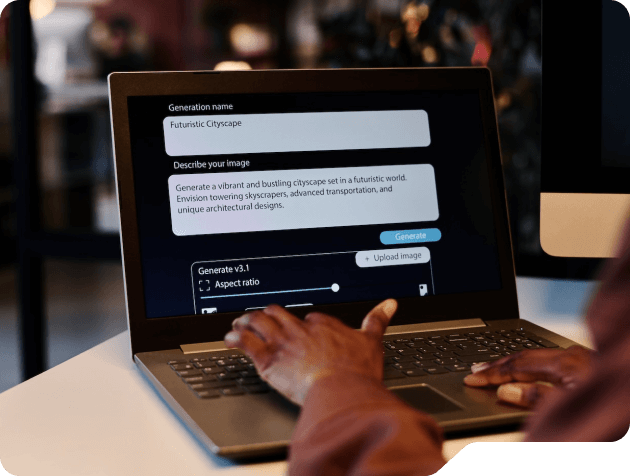In the ever-evolving world of digital marketing, staying ahead of emerging trends is essential for businesses striving to maintain a competitive advantage.
In this fast-paced digital age, you will likely fall behind if you are not moving forward. As we look ahead to 2024, the digital landscape is set to undergo significant changes, presenting challenges and opportunities for marketers.
From the integration of artificial intelligence to the rise of voice search optimization, 2024 holds immense potential for marketers. As technology advances and consumer preferences evolve, those who stay ahead of the curve will have the opportunity to meet and exceed customer expectations in the digital age.
In this blog article, we will explore the top digital marketing trends to watch in 2024 and provide invaluable insights to anticipate shifts and capitalize on new opportunities in the digital landscape.
Artificial Intelligence (AI) Powered Marketing
AI is emerging as a game-changer, revolutionizing how businesses engage with their audiences. From personalized recommendations to predictive analytics, AI-powered marketing transforms how brands connect with consumers.
A. Personalized Customer Experiences
Delivering personalized customer experiences has become increasingly essential in digital marketing, especially in 2024.
Thanks to AI algorithms, businesses can now analyze vast amounts of data to gain deeper insights into customer preferences and behaviors. Brands can fine-tune their marketing efforts to deliver content and recommendations that feel tailor-made.
For instance, AI algorithms can analyze past purchases, browsing history, and engagement patterns to generate targeted product recommendations, Considering product popularity and availability.
But personalized marketing does not stop there. Regarding websites and digital platforms, AI can create experiences that adapt in real time based on each visitor’s preferences. It is like having a concierge guiding you through a website, showing you precisely what you want to see.
By leveraging AI algorithms to analyze data and gain insights into customer behavior, businesses can enhance engagement, drive conversions, and ultimately build stronger, more meaningful relationships with their audience.
B. Predictive Analytics
Predictive analytics powered by AI is a formidable tool for businesses navigating the complexities of consumer behavior and market trends.
By using AI algorithms, predictive analytics provides marketers with insights to anticipate shifts in the market landscape, identify potential opportunities, and make well-informed, data-driven decisions. It’s like having insider knowledge about where the market is headed.
Businesses can leverage predictive analytics to refine sales projections and optimize advertising campaigns, pinpointing the best times and channels to reach their target audience.
By understanding the trends and patterns uncovered by AI, marketers can make strategic choices about where to invest their time and resources.
C. Marketing Automation
Marketing automation is the ultimate game-changer for businesses when it comes to streamlining processes and maximizing productivity.
Marketing automation tools streamline repetitive tasks and workflows, giving marketers the gift of time. Marketers can redirect their focus toward strategic initiatives and creative endeavors by automating routine processes, such as data analysis and campaign scheduling.
One of the most exciting applications of AI in marketing automation is through chatbots. Chatbots can provide instant customer support, answer FAQs, and guide users through the sales funnel.
By automating repetitive tasks and harnessing the capabilities of AI, marketers can unlock new levels of efficiency, productivity, and personalization
D. Content Creation and Optimization
In 2024, AI-driven content creation and optimization are set to redefine how businesses engage with their audience.
AI-powered tools have revolutionized content creation, enabling businesses to effortlessly produce high-quality content across various platforms. From blog posts to social media captions, these algorithms can save valuable time for marketers.
At the heart of AI-driven content creation lies natural language processing (NLP) technology, which enables AI to mimic human language and create more authentic content.
While AI can provide valuable insights and automate specific tasks, human oversight is crucial to ensure that content aligns with brand values and resonates authentically with the target audience.
Augmented and Virtual Reality (AR/VR)
As we look into 2024, Augmented Reality (AR) and Virtual Reality (VR) continue to reshape how businesses interact with consumers and are set to reach new heights.
AR and VR technologies offer businesses innovative ways to engage consumers through immersive experiences. With AR, digital content overlays onto the real world, while VR transports users to entirely virtual environments.
One of the most exciting applications of AR/VR in digital marketing is experiential marketing. Brands can create immersive experiences, allowing consumers to interact with products and services unimaginably.
From virtual try-on experiences for fashion brands to virtual tours of real estate properties, AR/VR enables brands to bring their offerings to life.
AR/VR also offers opportunities for brands to engage consumers through immersive storytelling to create content that drives deeper engagement and emotional connections with consumers.
By utilizing Augmented and Virtual Reality, businesses can create unforgettable experiences, drive engagement, and forge deeper connections with their audiences in the ever-evolving digital landscape.
The Rise of Voice Search
Voice search has rapidly gained prominence in recent years, transforming how users interact with technology. As businesses adapt to this evolving landscape, exploring the implications and strategies associated with the rise of voice search becomes crucial.
A. Understanding the Shift to Voice Search
With voice-enabled devices, such as smart speakers and virtual assistants, becoming increasingly popular, the shift in consumer behavior is more prevalent than ever.
In the fast-changing digital marketing world, users continually rely on voice search for instant gratification and seamless experiences, allowing them to retrieve information effortlessly with natural language commands.
Rather than typing queries into a search engine, users now turn to voice commands to find information, make inquiries, and perform tasks hands-free. Moreover, the rise of voice-activated devices has democratized access to information, making it accessible to individuals of all ages and technological proficiencies.
As voice search spreads in everyday life, businesses must recognize the significance of this shift in consumer behavior and adapt their marketing strategies accordingly.
B. Refining Keyword Strategies
One of the critical considerations in optimizing for voice search is adjusting keyword strategies accordingly to align with how people naturally talk.
Unlike traditional SEO, voice search queries tend to mimic natural language and often take the form of questions or phrases. Businesses should focus on incorporating conversational phrases and long-tail keywords into their content optimization efforts.
By identifying common questions and phrases related to their products or services, businesses can better tailor their keyword strategies to match the language used in voice searches.
Long-tail keywords, which consist of three or more words, play a crucial role in voice search optimization. These keywords capture the specific variations of voice queries and are more likely to align with how users speak when interacting with voice assistants.
Another factor to consider is Semantic search, which considers the context and intent behind a user’s query. To optimize, businesses should provide comprehensive answers to common questions and address related topics within their content.
C. Importance of Local SEO
With many voice searches being location-specific, businesses must prioritize local SEO efforts to ensure visibility in relevant voice search results.
One of the key strategies for optimizing local visibility in voice search is to focus on incorporating location-specific keywords into business listings and content. By strategically including these keywords in business descriptions, website content, and meta tags, businesses can increase their chances of appearing in voice search results for local queries.
Geo-targeting content is also an effective strategy for improving local visibility in voice search. This can include creating blog posts, articles, and other content that addresses local events, news, and trends and features local landmarks and attractions.
Another critical aspect of local SEO for voice search is claiming and optimizing Google My Business listings, which can enhance your business’s visibility in voice search results.
As voice search continues to gain momentum, businesses prioritizing local SEO will be better positioned to capitalize on this emerging trend and stay ahead of the competition.
Customer Experience Optimization
In the dynamic and ever-evolving digital marketing landscape, optimizing the customer experience has emerged as a critical strategy for businesses seeking to stand out and foster meaningful connections with their audience.
A. Personalization
Creating experiences that suit individual preferences and behaviors is paramount in today’s competitive landscape.
Businesses can leverage advanced data analytics and AI-driven insights to understand their customers’ needs and preferences better. Brands can deliver highly relevant content, product recommendations, and offers that resonate with each customer by segmenting their audience and creating targeted campaigns.
Targeted ads on digital platforms can be optimized to reach specific audience segments, delivering messages tailored to their interests and preferences. Brands can increase engagement and drive conversions by sending personalized recommendations or exclusive offers.
By customizing website interactions based on individual user behavior, businesses can enhance the customer experience and create a more personalized and engaging interaction.
This increases the likelihood of conversions and fosters a sense of connection and loyalty among customers.
B. Omnichannel Experience
With the increasing use of smartphones, tablets, and other connected devices, customers interact with businesses through various touchpoints, from websites and mobile apps to social media platforms.
As a result, providing an omnichannel experience has become imperative for businesses seeking to meet their customers’ evolving needs and expectations.
Whether customers are looking at products on a mobile app, researching reviews online, or scrolling through a website, they expect a consistent brand experience every step of the way. This requires businesses to integrate their digital channels seamlessly to ensure a cohesive experience at all touch points.
Ultimately, businesses delivering a seamless omnichannel experience are better positioned to meet the needs and expectations of digital consumers.
C. Ease of Use
Ensuring ease of use is vital to optimizing the customer experience in the evolving digital landscape. From seamless website navigation to service offerings, every interaction should be designed with simplicity and efficiency.
By eliminating unnecessary steps and simplifying complex tasks, businesses can enhance the overall customer experience and increase customer satisfaction. It will reduce bounce rates, improve conversion rates, and foster positive perceptions of your business.
Another factor is understanding user experience (UX) to identify pain points and address usability issues. Businesses can gain valuable insights into customer preferences and behaviors by conducting usability testing, analyzing user feedback, and leveraging data-driven insights.
To significantly improve the user experience, businesses can implement features like autocomplete search bars, one-click checkout options, and intuitive navigation menus.
By delivering intuitive and seamless experiences, businesses can attract and retain customers and drive long-term loyalty and advocacy.
D. Speed and Efficiency
In the fast-paced digital world, speed and efficiency are crucial factors that can make or break the customer experience, as customers expect prompt and efficient service across all touchpoints.
Optimizing response times and minimizing wait times are critical strategies for enhancing speed and efficiency in customer interactions. Customers highly value their time, whether waiting for a web page to load or awaiting a response to an email inquiry.
By ensuring quick and seamless website performance, businesses can minimize the frustration associated with slow loading times and provide a more satisfying browsing experience.
As customers continue to emphasize convenience and efficiency in their interactions with businesses, those who prioritize quick and responsive service will distinguish themselves and garner loyalty.
Sustainability and Social Responsibility
Sustainability and social responsibility play crucial roles in shaping purchasing choices today. Businesses can capitalize on this trend by adjusting their digital marketing strategies to stay ahead of their competition.
Businesses must incorporate sustainability and social responsibility into their digital marketing strategies to effectively connect with socially conscious consumers. These components, from product sourcing to marketing messages, cultivate a positive brand image and appeal to consumers.
Transparent communication is also another factor in building trust with consumers. Brands can highlight their initiatives, milestones, and the positive impact that they have made. This transparency builds trust with consumers and fosters deeper connections and brand loyalty.
Through targeted digital marketing campaigns, businesses can leverage the power of social media to inspire their audience and reinforce their commitment to driving positive change in the digital realm.
Conclusion
The top digital marketing trends in 2024 hold a new era of opportunity and growth for businesses eager to thrive in a rapidly evolving digital landscape, presenting both challenges and opportunities.
From leveraging artificial intelligence to enhance marketing strategies, optimizing for voice search, and creating immersive experiences through augmented and virtual reality, opportunities for innovation and growth are limitless. These trends continue to reshape how businesses engage with consumers, offering new avenues for connection, engagement, and conversion.
By staying ahead of these emerging trends and embracing the latest advancements in digital marketing, businesses can position themselves for success in the fast-paced and ever-evolving digital age.
At AVINTIV, we understand the importance of staying ahead of the curve in the ever-evolving digital landscape. With over 12 years of experience building and nurturing over 400 brands, we have the expertise and insight to help your business grow in 2024 and beyond.
If you are ready to elevate your business to new heights and exceed your goals, our team of strategists is here to help. Reach out to us today, and let’s collaborate to drive innovation, growth, and success for your brand in the fast-paced and ever-evolving world of digital marketing.
After all, brands choose to partner with AVINTIV when they want to do one thing: GROW!






